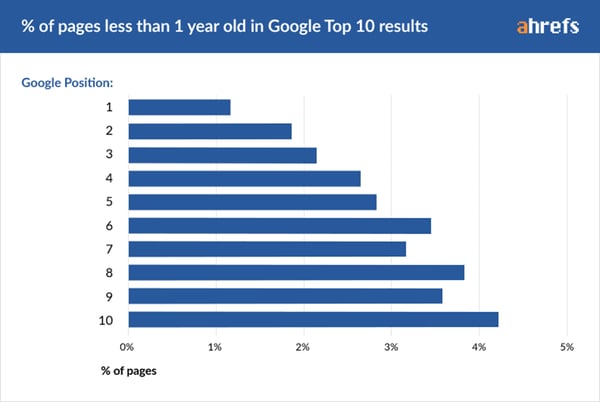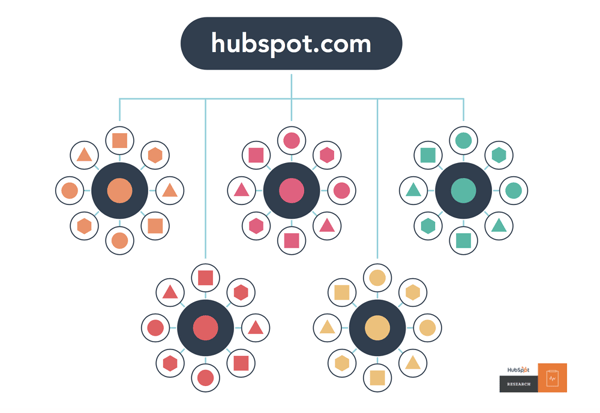Imagine if you could publish a piece of content today that will still drive tons of traffic five years from now.
Consider this: our top ranking article over the past year was written in 2016.
The reason a three-year-old article is still drawing in nearly 1,000 views a month is that we created a piece of content that's still relevant today. You can read it for yourself.
One method of generating content is to find something trending, throw out some ideas, and hope it catches. While this is one of the easiest methods to create content, it's not the best for bringing in traffic. The companies that succeed with this approach are paying dozens of authors to churn out multiple pieces a week.
If you want to take an approach that lets your content snowball, drawing in more traffic, month by month, you need to focus on making it evergreen.
6 Steps to Creating Evergreen Content That Dominates the SERPs
Few pages earn a top rank in the first month.
Even some of the world's top content marketers are waiting half a year before they see their content make it to the top of the SERPs. But seeing the stats above should offer some hope. When it hits that year mark, odds are in your content's favor that'll start performing better (more on this later). The catch is that it still needs to be valuable when it hits that mark, otherwise, more relevant content will overtake it.
This is why creating evergreen content is so useful. It's kind of like making soup. You put the pot on the stove, add your ingredients, and let it sit. Now, these ingredients have to be wholesome. If they evaporate too fast or get so soft they fall apart, they're no good.
Now and then you'll check in on it, stirring it up. But over time, the scent will fill your home, drawing in a crowd.
Sure, they may try some and enjoy it, but when it hits its peak point, where all the ingredients are tender and the flavor is infused in every bite, that's when you've made something worth talking about. Your family might invite your neighbors or some relatives, and then they may talk about the soup at work or elsewhere.
If the content you create needs time to simmer, you have to pack enough awesome ingredients into the piece so when the time comes, it's amazing.
But while the idea of creating content that still holds true months or years from now may seem daunting, if you can follow these five steps, you'll be generating evergreen content in no time.
1. Focus On Your Audience
To truly generate content that remains relevant, you need to focus on who is engaging with your work. This is the basis of customer-centric marketing, helping you build trust and credibility with your customers.
To do this, you need a thorough understanding of what your audience needs, feels, and enjoys. The easiest way to do this is to change the question, "Who are we targeting," to, "Who are we trying to help?"
This simple change brings the focus to providing a solution to their problem, not trying to sell them something. By addressing their pain points with the intent of alleviating them, you're offering solutions that resonate. The result is more content that's useful and will stand the test of the time.
2. Brainstorm Content Ideas
With your audience in mind, you need to brainstorm content ideas that will generate engagement.
A great way to come up with content ideas is through topic clusters. This approach lets you take the general concepts you want to cover, and then generate tons of ideas about everything within that keyword or phrase. Topic clusters are effective because they hone in on the exact words your audience is using to search for their solution, and the related phrases will promote your search engine rankings.
When generating ideas, don't be afraid to exhaust a topic and take down any keyword that could be relevant to your audience. You never know what content could resonate with them, and if you limit yourself to a single frame of mind, you'll never explore what else they care about.
There are some factors like difficulty score and monthly search volume that will illustrate the better choices from a content marketing standpoint. But if you're brainstorming the topics people are curious about, you'll be in range.
3. Ensure it Qualifies as Evergreen
To decide if something is evergreen-worthy, you should narrow down whether someone will find value reading it one year from now.
At the one year mark, the reason your content stands a better chance at performing is because of the various metrics it has developed. You see, a piece of content that's a month old will likely have fewer visitors than one that's older. Even if people stay on the page for minutes and the bounce rate is low, if only a handful of users viewed the content, it doesn't give Google a lot to go off.
This isn't to say you shouldn't aim for the results of that younger article. That would send it over the top. But when you hit that year mark, your content has had time to thrive. It should have significantly more internal and external links pointing towards it, and its traffic should be dramatically higher.
This shows Google it's a valuable piece of content.
Deciding if something is evergreen comes down to addressing what your audience will need, no matter what's trending at the time. If you sell eyeglasses, for example, a video series about how to avoid eye strain will provide value year after year, where a video on popular frame shapes will quickly become outdated.
It's these timeless topics that you need to consider for your evergreen strategy.
4. Use the Format Best Suited for the Content
You're not limited in the formatting of content if you want it to be evergreen, either. Almost any type of content can earn the status. It comes down to finding the medium that's best to tell the story.
Blogging is one of the most popular mediums because of the ease of use. Compared to video creation, it doesn't require much equipment to produce a high-quality end product. But even with that in mind, Gary Vaynerchuk has shown that recording yourself with your phone can be effective if the message works on the medium.
Neil Patel, on the other hand, produces great written content. Although his videos still offer useful information, they can feel awkward and are generally less informative than his massive blog posts. He also produces a podcast that takes advantage of the conversational approach to explore topics.
You're not limited to a single medium, either. You can combine formats to highlight specific points. If you have a video that better explains something in your blog post, embed it. This increases the value of your content by making it more digestible for a larger audience. It can also help in driving home to point you're trying to make.
5. Update Content As Necessary
Even evergreen content can need freshening to ensure the information provided is up to date. In fact, you should consider incorporating rewrites and refreshes throughout the year to ensure your content stays relevant.
In the soup metaphor from earlier, at some point, all the ingredients are going to boil down, and you won't be able to tell what's in it. The concept is similar to refreshes. At some point, the material is going to be less useful in its current state. If you can add fresh work to the piece, it'll bring it back to life, extending the content's value.
To determine whether content needs a refresh, you'll have to look at your data. The optimal pieces you're looking for are over a year old, a slowing in traffic, and have relevant information that can be added. You can address other pieces, but you'll get the most out of your time if you focus on the content with these attributes.
The reason you want it to be at least a year old is so you have data collected on it. Doing a refresh after two months of a content's publishing does nothing for you because you haven't seen how it'll actually perform.
If it's slowing in traffic, and you can see the trend, that means it may be viewed as less valuable than some of the other content that's come out since its publishing.
And finally, if you have no additional information to add to the piece, then there's no sense in just rearranging the words unless it makes it easier to consume.
When you do a refresh, Google acknowledges your changes. This is good because it shows you're fixing errors and providing updated information for your audience, but it's also potentially dangerous if you change too much. In that instance, you're changing your content's SEO results, meaning it may not perform as well for the keyword you previously targeted.
6. Repurpose Your Top Content
If you have content that's already proven to be effective over the course of time, there's no reason you shouldn't be repurposing it.
Repurposing content involves taking a single asset and turning it into significantly more. This means your blog post can become a video, an audio file, a social post, an infographic, or anything you can think of. It's a great way to extend the use of a single piece, allowing you to keep up with the competition without drastically increasing your workload.
By focusing on repurposing your evergreen content, you have an added edge. You already know how it's performing in its current medium, and you've seen how people engage with it. These insights will help you identify the best format for you repurposed content to earn engagement.
Building a Content Marketing Strategy for Growth
While you should strive to create evergreen content so your site can constantly increase its traffic, there's still place for other content. Creating pieces focused on trending terms can be a great way to increase awareness of your site and product, driving new customers who can then engage with your other material. Still, by focusing on evergreen content, you'll create material that customers will continue to enjoy.







